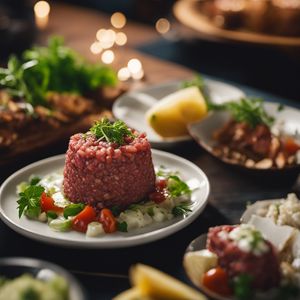
Dish
Birnenhonig
Pear honey
Birnenhonig is made by cooking ripe pears with honey until they are soft and caramelized. The mixture is then pureed and strained to create a smooth spread. This condiment is high in natural sugars and should be consumed in moderation. It is a great source of vitamins and minerals, including vitamin C and potassium. Birnenhonig is a popular condiment in Germany and is often served with cheese and bread. It can also be used as a glaze for roasted meats.
Origins and history
Birnenhonig has been a traditional German condiment for centuries. It was originally made by farmers as a way to preserve their excess fruit and honey. Today, it is a popular condiment that is enjoyed throughout Germany and beyond.
Dietary considerations
Suitable for: Vegetarians. Not suitable for: Vegans, people with fructose intolerance. Suggestions: Consume in moderation due to high sugar content.
Variations
There are many variations of Birnenhonig, including those that use different types of honey or spices. Some recipes also call for the addition of lemon juice or zest for a tangy twist.
Presentation and garnishing
When making Birnenhonig, be sure to use ripe pears for the best flavor. You can also experiment with different types of honey to create a unique flavor profile. Birnenhonig can be presented in a small dish or jar and garnished with fresh herbs or a drizzle of honey for added sweetness.
Tips & Tricks
To make Birnenhonig, use a heavy-bottomed pot to prevent burning. Stir frequently to ensure even cooking.
Side-dishes
Birnenhonig is often served with bread and cheese, but it can also be used as a glaze for roasted meats. It pairs well with pork, chicken, and beef.
Drink pairings
Birnenhonig is traditionally served with tea or coffee. It can also be paired with white wine or champagne.
Delicious Birnenhonig recipes
More dishes from this category... Browse all »

Apple Butter
American cuisine

Cervelle de canut
French cuisine

Chapda Chutney
Indian cuisine

Chintextle
Mexican cuisine

Crema del Gerrei
Italian cuisine

Cretons
Canadian cuisine

Culadur
Corsican cuisine

Filet Americain
Dutch cuisine
More cuisines from this region... Browse all »

Baden cuisine
Savory, Hearty, Tangy, Smoky, Sweet

Bavarian cuisine
Savory, Hearty, Tangy, Sour, Sweet

Brandenburg cuisine
Savory, Earthy, Hearty

Franconian cuisine
Hearty, Savory, Flavorful

Hamburg cuisine
Light, Flavorful, Fresh

Hessian cuisine
Hearty, Savory, Flavorful

Lower Saxon cuisine
Savory, Hearty, Salty, Sour, Sweet

Mecklenburg cuisine
Fresh, Simple, Rustic, Savory
